|
Show
jumping is a form of competition in which horses
are jumped over a course of fences, low walls, and other obstacles
(e.g., water-filled ditches or troughs). Show
jumping is a competitive sport consisting of many elements. The
course is pre-arranged; the event may be timed or untimed. It is
scored by a judge or panel of judges. Show jumping or
"jumpers" is a member of a family of English-discipline
equestrian events that includes hunters and equitation. Events that
include these sports are called hunter/jumper horse shows.
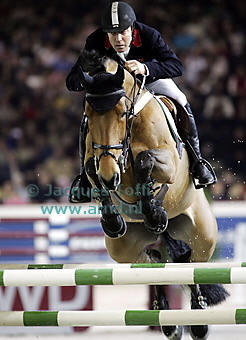
Grand Prix show
jumping
Overview
There are four types of jumping disciplines: Hunter, Equitation,
Jumper(show jumping), and Stadium Jumping Courses (with combined three
day eventing). In a Hunter style course, courses are designed for a
smooth, flowing performance of the horse. A rider should demonstrate
an even pace over fences simulating those found in the natural hunting
field. In competition, a horse is judged on its performance, manners,
and way of going. An even, steady pace, consistently good takeoff
distances, good jumping style, long, low movement, and overall
smoothness and ease of performance are paramount. If a horse ticks, or
touches, the fence he is jumping with his fore or hind legs, a fault
is added to the score.
Jumper courses are held over a course of show jumping obstacles,
including verticals, spreads, double and triple combinations, and many
turns and changes of direction. The more professional the class, such
as a Grade A class, the more technical the strides between each fence
becomes. For example they would make a related combination with the
normal horse canter stride of six strides between each fence and
change it to six and a half strides to make it more complicated for
the rider. The purpose is to jump cleanly over a twisting course
within an allotted time; jumping faults are incurred for knockdowns
only (as compared to ticks), disobedience, and time faults for
exceeding time allowance. Tied entries jump over a raised and
shortened course; if entries are tied in the jump-off, the fastest
time wins. Riders walk both course and the jump-off course before
competition, to plan their ride.
Jumper courses are highly technical, requiring boldness, scope,
power, accuracy, and control; speed is also a factor, especially in
jump-off course and speed classes (in which time counts in the first
round). A jumper must jump big, bravely, and fast, but he must also be
careful and accurate to avoid knockdowns, and must be balanced and
rideable in order to rate and turn accurately. A jumper rider must
ride the best line to each fence, saving ground with well-planned
turns and lines, and must adjust his horse's stride for each fence and
distance, while avoiding knockdowns. In a jumpoff, he must balance the
need to go as fast as possible and turn as tight as he can, against
his horse's ability to jump cleanly.
The horses are allowed a certain number of refusals to take a jump
or other obstacle, but fault points are added to their score for each
one. Until recently, it was 3 faults, but was changed to 4 faults by
the FEI (Federation Equestrian International) as it was decided that
it is better for the horse to attempt the jump rather than to refuse
it and should therefore not be penalized less for a more severe fault.
If they take more than the time allowed for the course, they earn one
fourth fault for each extra second. For every pole that is knocked
down, four faults are earned.
The final rankings are based on the lowest number of points
accumulated. In case of a draw, the horse with the fastest time ranks
higher.
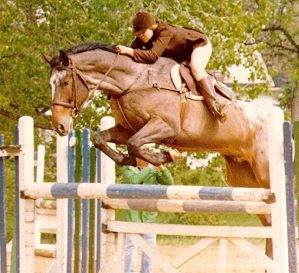
Grace,
beauty and skill
History of show jumping
Show jumping is a relatively new equestrian sport. Until the
Enclosures Acts which came into force in England
in the eighteenth century there had been no need for a horse to jump
fences as there had been none. But with this act of parliament came
new challenges for those followers of fox hounds. The enclosures act
brought fencing and boundaries to many parts of the country as common
ground was dispersed amongst the wealthy landowners. This meant that
those wishing to pursue their sport now needed horses which were
capable of jumping these obstacles.
In the early shows held in France
there was a parade of competitors who then took off across country for
the jumping. This sport was, however, not popular with spectators as
they could not watch the jumping. Soon after the introduction of these
parades fences began to appear in the arena. This became known as ‘Lepping’.
Fifteen years later, ‘Lepping’ competitions were brought to Britain
and by 1900 most of the more important shows had ‘Lepping’ classes
although they rarely attracted more than 20 competitors. The ladies,
riding side-saddle, had their own classes.
At this time, the principal cavalry schools of Europe at Pinerolo
and Tor-di-Quinto in Italy, the French school in Saumur and the
Spanish school in Vienna preferred to use a backward seat when jumping
for safety purposes with long length stirrups. The Italian Instructor
Captain Fiederico Caprilli heavily influenced the forward seat with
his ideas that the forward position would not impede the balance of
the horse negotiating obstacles. It is this latter style which is
commonly used today.
The first big
show jumping class to be held in England was in the
Horse of the Year Show at Olympia in 1907. Most of the competitors
were servicemen and it became clear at this competition and in the
subsequent years that there was no uniformity of rules for the sport.
Judges marked on their own opinions. Some marked according to the
severity of the obstacle and others marked according to style. Before
1907 there were no penalties for a refusal and the competitor was
sometimes asked to miss the fence to please the spectators. The first
courses were built with little imagination; many consisting of only a
straight bar fence and a water jump. A meeting was arranged in 1923 to
rectify it and this led to the formation of the BSJA in 1925.
Today
, show jumping has come a long way in a relatively short time. Jumping
courses are now highly technical , requiring boldness, scope ,power,
accuracy and control from both horse and rider. In the early days the
time element did not count and water jumps always contained water
until it eventually drained away ( benefiting the later drawn
horses in the competition ) . Further , it was some years before a
competitor was penalised for circling between obstacles. In addition ,
the high jump would start with a single pole at a height of 5ft. (
1.52m ) but this style of competition was abandoned due to the
horses considering the easier option of going under the pole ! and led
to the fillers and multiple poles etc that are seen on present day
courses.
Show
Jumping was introduced to the Olympic
Games in 1912 and has thrived ever since. There have been calls
recently to have all equestrian sports removed from the Olympics based
upon the argument that the Olympics is about man competing against man
and that there should be no involvement nor competition between any
other living species. Well fortunately that argument did not gain much
favour and we at Greenacres Stud cant wait to attend our first
Olympics in London's Greenwich park in 2012. To list all the
achievements of all the past great Olympic Horses would itself take
until nearly 2012 to compile. We would however just like to give a
very quick mention to just 2.... Milton who is a part Trakehner ( the
breed close to our heart ) and Ahorn who is the grand sire of our own
Dutch Warmblood Greenacres Hajla - Z and Holstein Warmblood Greenacres
Hekabo - Z .
Original scoring tariff
The original list of faults introduced in 1925 was as follows:
Refusing or Running out at any fence:
-
1st: 8 faults
-
2nd: 8 faults
-
3rd: Elimination
Fall of Horse or Rider or both: Elimination
Horse touches a fence without knocking it down, then there are no
faults, as they are only incurred if a pole or any part of the jump is
knoked down.
For every jump that is knoked down 4 faults are incurred. The same
as for a water jump, if a horse has lands with one foot or more than
one in the water there are still only 4 faults incurred.
Water jumps were at least 15 feet (5 metres) wide although the
water had often drained out of them before the last competitor jumped
them. High jumping would start with a pole at around 5 foot but this
was later abandoned as many horses went under the pole. It was for
this reason that more poles were added and fillers came into use. In
the early days time penalties did not count and competitors were not
penalized until 1917. Showjumping was first incorporated into the
Olympic Games in 1912 and has thrived ever since, its popularity due
in part to its suitability as a spectator sport which can be viewed on
television.
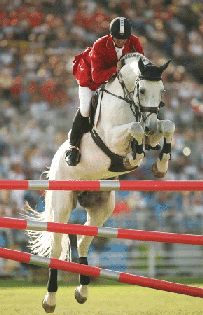
Great
technique
The horses
Some horse breeds have characteristics tailored for different
styles of jumping.
Some of the great show jumping horses in history have been:
-
Abdullah
-
Baloubet du Rouet
-
Big Ben
-
Boomerang
-
Dobels Cento
-
Galoubet A
-
Gem Twist
-
Grannus
-
Halla
-
Heartbreaker
-
Milton
-
Monopoly
-
Nimmerdor
-
Ramiro Z
-
Robinson
-
Snowball
-
Snowman
-
Stroller
|
Stevenson R
& R Jewellers
Telephone: 01444 416801
Address: 2-3 Park Parade, South Road,
Haywards Heath, RH16 4LX
Quality,
value and service. For all your jewellery
needs.
Sponsors of : Borde
Hill Horse Trials
In
aid of 
Tel:
01483 898786
http://www.spinal-research.org/
The
Stevensons Jewellers Challenge Final 25 June, 2006
Another
superb event, very entertaining and great fun for the
competitors and spectators. The 8th event in this
series, was held at The Golden Cross Equestrian Centre near
Hailsham. Click here for details
The
Stevensons Jewellers Challenge Final 2 July, 2004
On Sunday June 27th, Lower Stunts Green eventer Penny Sangster
&
Greenbank Harlequin won the sixth running of the Stevensons
Jewellers
Challenge Final at Golden Cross Equestrian
Centre, with the Sussex
eventers holding their own against the Sussex showjumpers
taking the top
four places.
Sponsor, Haywards Heath jeweller Russell Stevenson said, 'I
was pleased
the crowd stayed on. The bank was solid with them. Although
the eventers
dominated this year, I have to be honest and say it's a little
bit more
favourable to them. But everyone had fun and it's been
wonderful.
Organiser Ian Bareham and course designer Keith Bristow worked
so hard
to put this on.'
|
OLYMPIC EQUESTRIAN MEDALISTS
|
Year
|
Gold
|
Pts.
|
Silver
|
Pts.
|
Bronze
|
Pts.
|
|
1912
|
Axel Norlander, SWE
Lady Artist
|
46.59
|
Friedrich von Rochow, GER
Idealist
|
46.42
|
Jean Cariou, FRA
Cocotte
|
46.32
|
|
1920
|
Helmer Mörner, SWE
Germania
|
1775.00
|
Åge Lundström, SWE
Ysra
|
1738.75
|
Ettore Caffaratti, ITA
Caniche
|
1733.75
|
|
1924
|
Adolph van der Noort van Zijp, NED
Silver Piece
|
1976
|
Frode Kirkebjerg, DEN
Meteor
|
1853.5
|
Sloan Doak, USA
Pathfinder
|
1845.5
|
|
1928
|
Charles Pahud de Mortanges, NED
Marcroix
|
1969.82
|
Gerard de Kruyff, NED
Va-tt-en
|
1967.26
|
Bruno Neumann, GER
Ilja
|
1944.42
|
|
1932
|
Charles Pahud de Mortanges, NED
Marcroix
|
1813.833
|
Earl Thomson, USA
Jenny Camp
|
1811.000
|
Clarence von Rosen, SWE
Sunnyside Maid
|
1809.415
|
|
1936
|
Ludwig Stubbendorff, GER
Nurmi
|
37.70
|
Earl Thomson, USA
Jenny Camp
|
99.90
|
Hans Mathiesen-Lunding, DEN
Jason
|
102.20
|
|
1948
|
Bernard Chevallier, FRA
Aiglonne
|
+4.00
|
Frank Henry, USA
Swing Low
|
21.00
|
Robert Selfelt, SWE
Claque
|
25.00
|
|
1952
|
Hans von Blixen-Finecke II, SWE
Jubal
|
28.33
|
Guy Lefrant, FRA
Verdun
|
54.50
|
Wilhelm Büsing, GER
Hutbertus
|
55.50
|
|
1956
|
Petrus Kastenman, SWE
Iluster
|
66.53
|
August Lütke-Westhues, GER
Trux von Kamax
|
84.87
|
Francis Weldon, GBR
Kilbarry
|
85.48
|
|
1960
|
Lawrence Morgan, AUS
Salad Days
|
+7.15
|
Neale Lavis, AUS
Mirrabooka
|
16.50
|
Anton Bühler, SUI
Gay Spark
|
51.21
|
|
1964
|
Mauro Checcoli, ITA
Surbean
|
+64.40
|
Carlos Moratorio, ARG
Chalan
|
+56.40
|
Fritz Ligges, GER
Donkosak
|
+49.20
|
|
1968
|
Jean-Jacques Guyon, FRA
Pitou
|
38.86
|
Derek Allhusen, GBR
Lochinvar
|
41.61
|
Michael Page, USA
Foster
|
52.31
|
|
1972
|
Richard Meade, GBR
Laurieston
|
+57.73
|
Alessandro Argenton, ITA
Woodland
|
+43.33
|
Jan Jönsson, SWE
Sarajevo
|
+39.67
|
|
1976
|
Edmund "Tad" Coffin, USA
Bally-Cor
|
114.99
|
Michael Plumb, USA
Better and Better
|
125.85
|
Karl Schultz, FRG
Madrigal
|
129.45
|
|
1980
|
Euro Frederico Roman, ITA
Rossinan
|
108.60
|
Aleksandr Blinov, URS
Galzun
|
120.80
|
Yuriy Salnikov, URS
Pintset
|
151.60
|
|
1984
|
Mark Todd, NZL
Charisma
|
51.60
|
Karen Stives, USA
Ben Arthur
|
54.20
|
Virginia Holgate, GBR
Priceless
|
56.80
|
|
1988
|
Mark Todd, NZL
Charisma
|
42.60
|
Ian Stark, GBR
Sir Wattie
|
52.80
|
Virginia Leng (Holgate), GBR
Master Craftsman
|
62.00
|
|
1992
|
Matthew Ryan, AUS
Kibah Tic Toc
|
70.00
|
Herbert Blöcker, GER
Feine Dame
|
81.30
|
Blyth Tait, NZL
Messiah
|
87.60
|
|
1996
|
Blyth Tait, NZL
Ready Teddy
|
56.80
|
Sally Clark, NZL
Squirrel Hill
|
60.40
|
Kerry Millikin, USA
Out and About
|
73.70
|
|
2000
|
David O'Connor, USA
Custom Made
|
34.00
|
Andrew Hoy, AUS
Swizzle In
|
39.80
|
Mark Todd, NZL
Eyespy II
|
42.00
|
|
2004
|
Leslie Law, GBR
Shear L'Eau
|
44.40
|
Kim Severson, USA
Winsome Adante
|
45.20
|
Philippa Funnell, GBR
Primmore's Pride
|
45.20
|
|
Year
|
Gold
|
Pts.
|
Silver
|
Pts.
|
Bronze
|
Pts.
|
|
1912
|
Sweden
|
139.06
|
Germany
|
138.48
|
United States
|
137.33
|
|
1920
|
Sweden
|
5057.50
|
Italy
|
4735.00
|
Belgium
|
4560.00
|
|
1924
|
Netherlands
|
5297.5
|
Sweden
|
4743.5
|
Italy
|
4512.5
|
|
1928
|
Netherlands
|
5865.68
|
Norway
|
5395.68
|
Poland
|
5067.92
|
|
1932
|
United States
|
5038.083
|
Netherlands
|
4689.083
|
Only two finishers
|
|
|
1936
|
Germany
|
676.65
|
Poland
|
991.70
|
Great Britain
|
9195.50
|
|
1948
|
United States
|
161.50
|
Sweden
|
165.00
|
Mexico
|
305.25
|
|
1952
|
Sweden
|
221.94
|
Germany
|
235.49
|
United States
|
587.16
|
|
1956
|
Great Britain
|
355.48
|
Germany
|
475.91
|
Canada
|
572.72
|
|
1960
|
Australia
|
128.18
|
Switzerland
|
386.02
|
France
|
515.71
|
|
1964
|
Italy
|
+85.80
|
United States
|
+65.86
|
Germany
|
+56.73
|
|
1968
|
Great Britain
|
175.93
|
United States
|
245.87
|
Australia
|
331.26
|
|
1972
|
Great Britain
|
+95.53
|
United States
|
+10.81
|
F.R. Germany
|
18.00
|
|
1976
|
United States
|
441.00
|
F.R. Germany
|
584.80
|
Australia
|
599.54
|
|
1980
|
Soviet Union
|
457.00
|
Italy
|
656.20
|
Mexico
|
1172.85
|
|
1984
|
United States
|
186.00
|
Great Britain
|
189.20
|
F.R. Germany
|
234.00
|
|
1988
|
F.R. Germany
|
225.95
|
Great Britain
|
256.80
|
New Zealand
|
271.20
|
|
1992
|
Australia
|
288.60
|
New Zealand
|
290.80
|
Germany
|
300.30
|
|
1996
|
Australia
|
203.85
|
United States
|
261.10
|
New Zealand
|
268.55
|
|
2000
|
Australia
|
146.80
|
Great Britain
|
161.00
|
United States
|
175.80
|
|
2004
|
France
|
140.4
|
Great Britain
|
143.0
|
United States
|
145.0
|
|
Year
|
Gold
|
Time/ Score
|
Silver
|
Time/ Score
|
Bronze
|
Time/ Score
|
|
1900
|
Aimé Haageman, BEL
Benton II
|
2:16.0
|
Georges van de Poële, BEL
Windsor Squire
|
2:17.6
|
Louis de Champsavin, FRA
Terpsichore
|
2:26.0
|
|
1904-08
|
Not held
|
|
|
|
|
|
|
1912
|
Jean Cariou, FRA
Mignon
|
4+5
|
Rabod Wilhelm von Kröcher, GER
Dohna
|
4+7
|
Emanuel de Blommaert de Soye, BEL
Clonmore
|
5
|
|
1920
|
Tommaso Lequio di Assaba, ITA
Trebecco
|
2
|
Alessandro Valerio, ITA
Cento
|
3
|
Carl-Gustaf Lewenhaupt, SWE
Mon Coeur
|
4
|
|
1924
|
Alphonse Gemuseus, SUI
Lucette
|
6
|
Tommaso Lequio di Assaba, ITA
Trebecco
|
8.75
|
Adam Królikiewicz, POL
Picador
|
10
|
|
1928
|
František Ventura, TCH
Eliot
|
0+0+0
|
Pierre Bertran de Balanda, FRA
Papillon
|
0+0+2
|
Charley Kuhn, SUI
Pepita
|
0+0+4
|
|
1932
|
Takeichi Nishi, JPN
Uranus
|
8
|
Harry Chamberlin, USA
Show Girl
|
12
|
Clarence von Rosen, SWE
Empire
|
16
|
|
1936
|
Kurt Hasse, GER
Tora
|
4+4/59.2
|
Henri Rang, ROM
Delfis
|
4+4/72.8
|
József Platthy, HUN
Sello
|
8+0/62.6
|
|
1948
|
Humberto Mariles, MEX
Arete
|
6.25
|
Rubén Uriza, MEX
Harvey
|
8+0
|
Jean d'Orgeix, FRA
Sucre de Pomme
|
8+4/38.9
|
|
1952
|
Pierre Jonquères d'Oriola, FRA
Ali Baba
|
8+0
|
Oscar Cristi, CHI
Bambi
|
8+4
|
Fritz Thiedemann, GER
Meteor
|
8+8/38.5
|
|
1956
|
Hans Günter Winkler, GER
Haila
|
4
|
Raimondo D'Inzeo, ITA
Merano
|
8
|
Piero D'Inzeo, ITA
Uruguay
|
11
|
|
1960
|
Raimondo D'Inzeo, ITA
Posillipo
|
12
|
Piero D'Inzeo, ITA
The Rock
|
16
|
David Broome, GBR
Sunslave
|
23
|
|
1964
|
Pierre Jonquères d'Oriola, FRA
Lutteur
|
9
|
Hermann Schridde, GER
Dozent
|
13.75
|
Peter Robeson, GBR
Firecrest
|
16+0
|
|
1968
|
William Steinkraus, USA
Snowbound
|
4
|
Marion Coakes, GBR
Stroller
|
8
|
David Broome, GBR
Mister Softee
|
12+0/35.3
|
|
1972
|
Graziano Mancinelli, ITA
Ambassador
|
8+0
|
Ann Moore, GBR
Psalm
|
8+3
|
Neal Shapiro, USA
Sloopy
|
8+8
|
|
1976
|
Alwin Schockemöhle, FRG
Warwick Rex
|
0
|
Michel Vaillancourt, CAN
Branch County
|
12+4
|
François Mathy, BEL
Gai Luron
|
12+8
|
|
1980
|
Jan Kowalczyk, POL
Artemor
|
8
|
Nikolay Korolkov, URS
Espadron
|
9.5
|
Joaquín Pérez, MEX
Alymony
|
12+4/43.23
|
|
1984
|
Joe Fargis, USA
Touch of Class
|
4+0
|
Conrad Homfeld, USA
Abdullah
|
4+8
|
Heidi Robbiani, SUI
Jessica V
|
8+0
|
|
1988
|
Pierre Durand, FRA
Jappeloup
|
1.25
|
Greg Best, USA
Gem Twist
|
4+4/45.70
|
Karsten Huck, FRG
Nepomuk
|
4+4/54.75
|
|
1992
|
Ludger Beerbaum, GER
Classic Touch
|
0
|
Piet Raymakers, NED
Ratina Z
|
0.25
|
Norman Dello Joio, USA
Irish
|
4.75
|
|
1996
|
Ulrich Kirchhoff, GER
Jus de Pommes
|
1
|
Willi Melliger, SUI
Calvaro
|
4+0/38.07
|
Alexandra Ledermann, FRA
Rochet M
|
4+0/41.46
|
|
2000
|
Joroen Dubbeldam, NED
Sjiem
|
4+0
|
Albert Voorn, NED
Lando
|
4+4/44.72
|
Khaled Al-Eid, KSA
Khashm Al Aan
|
4+4/44.86
|
|
2004
|
IRL Cian O'Connor, IRL
Waterford Crystal
|
4
|
BRA Rodrigo Pessoa, BRA
Baloubet du Rouet
|
8
|
USA Chris Kappler, USA
Royal Kaliber
|
8
|
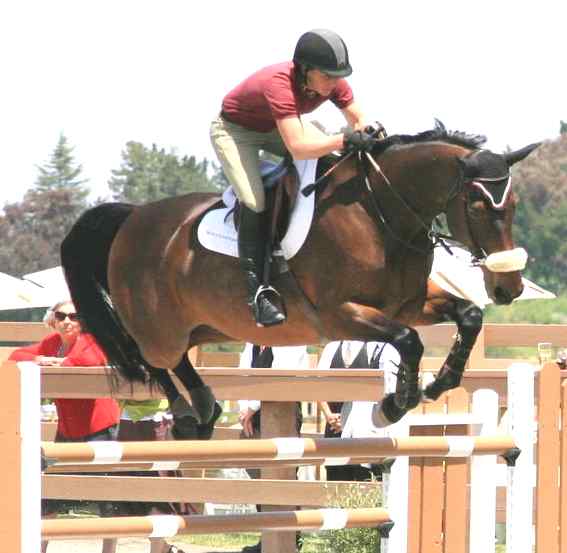
Kentucky
Derby
|
Year
|
Gold
|
Score
|
Silver
|
Score
|
Bronze
|
Score
|
|
1912
|
Sweden
|
25.00
|
France
|
32.00
|
Germany
|
40.00
|
|
1920
|
Sweden
|
14.00
|
Belgium
|
16.25
|
Italy
|
18.75
|
|
1924
|
Sweden
|
42.25
|
Switzerland
|
50.00
|
Portugal
|
53.00
|
|
1928
|
Spain
|
4.00
|
Poland
|
8.00
|
Sweden
|
10.00
|
|
1932
|
No finishers
|
|
|
|
|
|
|
1936
|
Germany
|
44.00
|
Netherlands
|
51.50
|
Portugal
|
56.00
|
|
1948
|
Mexico
|
34.25
|
Spain
|
56.50
|
Great Britain
|
67.00
|
|
1952
|
Great Britain
|
40.75
|
Chile
|
45.75
|
United States
|
52.25
|
|
1956
|
Germany
|
40.00
|
Italy
|
66.00
|
Great Britain
|
69.00
|
|
1960
|
Germany
|
46.50
|
United States
|
66.00
|
Italy
|
80.50
|
|
1964
|
Germany
|
68.50
|
France
|
77.75
|
Italy
|
88.50
|
|
1968
|
Canada
|
102.75
|
France
|
110.50
|
F.R. Germany
|
117.25
|
|
1972
|
F.R. Germany
|
32.00
|
United States
|
32.25
|
Italy
|
48.00
|
|
1976
|
France
|
40.00
|
F.R. Germany
|
44.00
|
Belgium
|
63.00
|
|
1980
|
Soviet Union
|
20.25
|
Poland
|
56.00
|
Mexico
|
59.75
|
|
1984
|
United States
|
12.00
|
Great Britain
|
36.75
|
F.R. Germany
|
39.25
|
|
1988
|
F.R. Germany
|
17.25
|
United States
|
20.50
|
France
|
27.50
|
|
1992
|
Netherlands
|
12.00
|
Austria
|
16.75
|
France
|
24.75
|
|
1996
|
Germany
|
1.75
|
United States
|
12.00
|
Brazil
|
17.25
|
|
2000
|
Germany
|
15.00
|
Switzerland
|
16.00
|
Brazil
|
24.00
|
|
2004
|
Germany
|
8
|
United States
|
20
|
Sweden
|
20
|
|
Year
|
Gold
|
Score
|
Silver
|
Score
|
Bronze
|
Score
|
|
1912
|
Carl Bonde, SWE
Emperor
|
15
|
Gustaf-Adolf Boltenstern, SWE
Neptun
|
21
|
Hans von Blixen-Finecke, SWE
Maggie
|
32
|
|
1920
|
Janne Lundblad, SWE
Uno
|
27.9375
|
Bertil Sandström, SWE
Sabel
|
26.3125
|
Hans von Rosen, SWE
Running Sister
|
25.1250
|
|
1924
|
Ernst Linder, SWE
Piccolomini
|
276.4
|
Bertil Sandström, SWE
Sabel
|
275.8
|
Xavier Lesage, FRA
Plumard
|
265.8
|
|
1928
|
Carl-Friedrich von Langen-Parow, GER
Draufgänger
|
237.42
|
Charles Marion, FRA
Linon
|
231.00
|
Ragnar Ohlson, SWE
Gunstling
|
229.78
|
|
1932
|
Xavier Lesage, FRA
Tame
|
6/343.75
|
Charles Marion, FRA
Linon
|
14/305.42
|
Hiram Tuttle, USA
Olympic
|
14/300.50
|
|
1936
|
Heinz Pollay, GER
Kronos
|
1760.0
|
Friedrich Gerhard, GER
Absinth
|
1745.5
|
Alois Podhajsky, AUT
Nero
|
1721.5
|
|
1948
|
Hans Moser, SUI
Hummer
|
492.5
|
André Jousseaume, FRA
Harpagon
|
480.0
|
Gustaf-Adolf Boltenstern II, SWE
Trumf
|
477.5
|
|
1952
|
Henri St. Cyr, FRA
Master Rufus
|
561.0
|
Lis Hartel, DEN
Jubilee
|
541.5
|
André Jousseaume, FRA
Harpagon
|
541.0
|
|
1956
|
Henri St. Cyr, FRA
Juli
|
860.0
|
Lis Hartel, DEN
Jubilee
|
850.0
|
Liselott Linsenhoff, GER
Adular
|
832.0
|
|
1960
|
Sergey Filatov, URS
Absent
|
2144.0
|
Gustav Fischer, SUI
Wald
|
2087.0
|
Josef Neckermann, GER
Asbach
|
2082.0
|
|
1964
|
Henri Chammartin, SUI
Wörmann
|
1504.0
|
Harry Boldt, GER
Remus
|
1503.0
|
Sergey Filatov, URS
Absent
|
1486.0
|
|
1968
|
Ivan Kizimov, URS
Ikhor
|
1572
|
Josef Neckermann, FRG
Mariano
|
1546
|
Reiner Klimke, FRG
Dux
|
1537
|
|
1972
|
Liselott Linsenhoff, FRG
Piaff
|
1229
|
Yelena Petushkova, URS
Pepel
|
1185
|
Josef Neckermann, FRG
Venetia
|
1177
|
|
1976
|
Christine Stückelberger, SUI
Granat
|
1486
|
Harry Boldt, FRG
Woycek
|
1435
|
Reiner Klimke, FRG
Mehmed
|
1395
|
|
1980
|
Elisabeth Theurer, AUT
Mon Cherie
|
1370
|
Yuriy Kovshov, URS(UZB)
Igrok
|
1300
|
Viktor Ugryumov, URS
Shkval
|
1234
|
|
1984
|
Reiner Klimke, FRG
Ahlerich
|
1504
|
Anne Grethe Jensen, DEN
Marzog
|
1442
|
Otto Hofer, SUI
Limandus
|
1364
|
|
1988
|
Nicole Uphoff, FRG
Rembrandt
|
1521
|
Margit Otto-Crépin, FRA
Corlandus
|
1462
|
Christine Stückelberger, SUI
Gaugain de Lully
|
1417
|
|
1992
|
Nicole Uphoff, GER
Rembrandt
|
1626
|
Isabell Werth, GER
Gigolo
|
1551
|
Klaus Balkenhol, GER
Goldstern
|
1515
|
|
1996
|
Isabell Werth, GER
Gigolo
|
235.09
|
Anky van Grunsven, NED
Bonfire
|
233.02
|
Sven Rothenberger, NED
Weyden
|
224.94
|
|
2000
|
Anky van Grunsven, NED
Bonfire
|
239.18
|
Isabell Werth, GER
Gigolo
|
234.19
|
Ulla Salzgeber, GER
Rusty
|
230.57
|
|
2004
|
Anky van Grunsven, NED
Salinero
|
79.278
|
Ulla Salzgeber, GER
Rusty
|
78.833
|
Beatriz Ferrer-Salat, ESP
Beauvalais
|
76.667
|
|
Year
|
Gold
|
Score
|
Silver
|
Score
|
Bronze
|
Score
|
|
1928
|
Germany
|
669.72
|
Sweden
|
650.86
|
Netherlands
|
642.96
|
|
1932
|
France
|
2818.75
|
Sweden
|
2678.00
|
United States
|
2576.75
|
|
1936
|
Germany
|
5074.0
|
France
|
4846.0
|
Sweden
|
4660.5
|
|
1948
|
France
|
1269.0
|
United States
|
1256.0
|
Portugal
|
1182.0
|
|
1952
|
Sweden
|
1597.5
|
Switzerland
|
1579.0
|
Germany
|
1501.0
|
|
1956
|
Sweden
|
2475.0
|
Germany
|
2346.0
|
Switzerland
|
2346.0
|
|
1960
|
Not held
|
|
|
|
|
|
|
1964
|
Germany
|
2558.0
|
Switzerland
|
2526.0
|
Soviet Union
|
2311.0
|
|
1968
|
F.R. Germany
|
2699
|
Soviet Union
|
2657
|
Switzerland
|
2547
|
|
1972
|
Soviet Union
|
5095
|
F.R. Germany
|
5083
|
Sweden
|
4849
|
|
1976
|
F.R. Germany
|
5155
|
Switzerland
|
4684
|
United States
|
4647
|
|
1980
|
Soviet Union
|
4383
|
Bulgaria
|
3580
|
Romania
|
3346
|
|
1984
|
F.R. Germany
|
4955
|
Switzerland
|
4673
|
Sweden
|
4630
|
|
1988
|
F.R. Germany
|
4302
|
Switzerland
|
4164
|
Canada
|
3969
|
|
1992
|
Germany
|
5224
|
Netherlands
|
4742
|
United States
|
4643
|
|
1996
|
Germany
|
5553
|
Netherlands
|
5437
|
United States
|
5309
|
|
2000
|
Germany
|
5632
|
Netherlands
|
5579
|
United States
|
5166
|
|
2004
|
Germany
|
74.653
|
Spain
|
72.917
|
United States
|
71.500
|
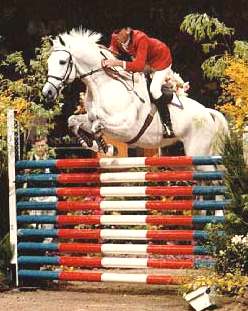
Gray
stallion Abdulla
Important show jumping events
-
CHIO
Aachen - The biggest show jumping tournament, in Aachen, Germany.
-
Spruce
Meadows in Calgary, Canada,
Tournaments include "The National", "The North
American", "Canada One", and "The
Masters"
-
The
British Open Show Jumping Championships - Top class
international Show Jumping, Horse Ball competitions and Thrilling
displays.
-
Horse
of the Year Show - The Show of Champions. Packed full of
action from both the showing and show-jumping worlds.
-
Horse
Chat Forums - Discuss show jumping with other enthusiasts.
-
London
International Horse Show - Information on the show, including
Quadrille dressage to music finals and the Shetland Grand
National, along with the international standard showjumping and
qualifiers.
-
Dubai
International Horse Show - The world's richest show jumping
competition offering a prize fund of USD 1,250,000. Also named as
Al Maktoum Challenge.
-
Indoor
Brabant Den Bosch - International Equine Event in Den Bosch,
The Netherlands.
-
Dublin
Horse Show - The Fáilte Ireland Dublin Horse Show is
Ireland's leading Equestrian and social event of the Summer.
Types of Show Jumping Jumps
-
Vertical - a jump that consists of poles right above each other
with no spread, or width, to jump.
-
Oxer - Basically two verticals close together, to make the jump
wider. Also called a spread.
- Square Oxer: Both top poles are of an equal height.
- Ascending Oxer: The furthest pole is higher than the first.
- Descending Oxer: The furthest pole is lower than the closest.
-
Triple - Three bars across, making a wide spread.
-
Wall - This type of jump is usually made to look like a brick
wall, but the "bricks" and constructed of a lightweight
material and fall easily when knocked.
-
Hog's Back - A type of jump where the tallest pole is in the
center.
-
Filler - This is not a type of fence but is a solid part below
the poles, such as flower boxes or a rolltop. It can alse be a
gate.
-
Combination - any number of jumps in a row, with a certain
number of strides in between.
-
Quadrupial- four jumps stratigiclly placed in a row
Video
Links

Baltic
Cup Shannon Mejnert - Sandy
A
- Z SPORTS INDEX
A
taste for adventure capitalists

Solar
Cola - a healthier alternative
|






